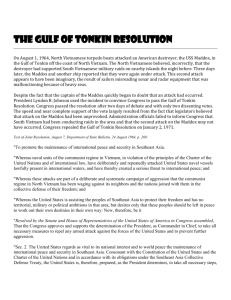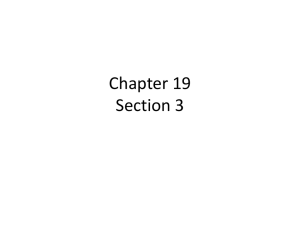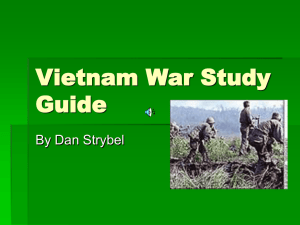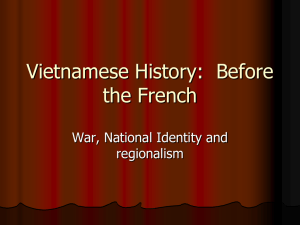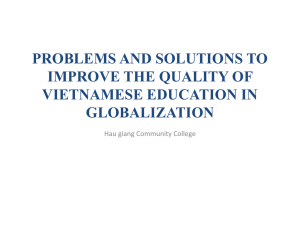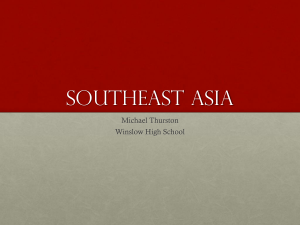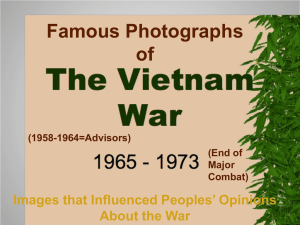DBQ What were we fighting
advertisement
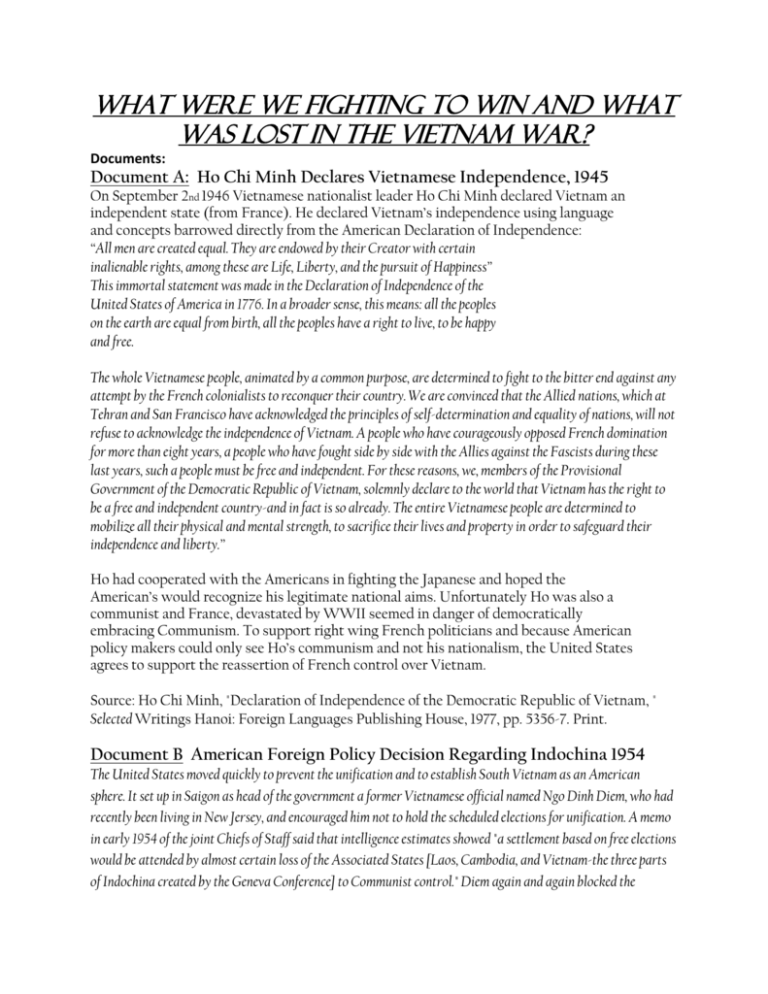
What were we fighting to win and what was lost in the Vietnam War? Documents: Document A: Ho Chi Minh Declares Vietnamese Independence, 1945 On September 2nd 1946 Vietnamese nationalist leader Ho Chi Minh declared Vietnam an independent state (from France). He declared Vietnam’s independence using language and concepts barrowed directly from the American Declaration of Independence: “All men are created equal. They are endowed by their Creator with certain inalienable rights, among these are Life, Liberty, and the pursuit of Happiness” This immortal statement was made in the Declaration of Independence of the United States of America in 1776. In a broader sense, this means: all the peoples on the earth are equal from birth, all the peoples have a right to live, to be happy and free. The whole Vietnamese people, animated by a common purpose, are determined to fight to the bitter end against any attempt by the French colonialists to reconquer their country. We are convinced that the Allied nations, which at Tehran and San Francisco have acknowledged the principles of self-determination and equality of nations, will not refuse to acknowledge the independence of Vietnam. A people who have courageously opposed French domination for more than eight years, a people who have fought side by side with the Allies against the Fascists during these last years, such a people must be free and independent. For these reasons, we, members of the Provisional Government of the Democratic Republic of Vietnam, solemnly declare to the world that Vietnam has the right to be a free and independent country-and in fact is so already. The entire Vietnamese people are determined to mobilize all their physical and mental strength, to sacrifice their lives and property in order to safeguard their independence and liberty.” Ho had cooperated with the Americans in fighting the Japanese and hoped the American’s would recognize his legitimate national aims. Unfortunately Ho was also a communist and France, devastated by WWII seemed in danger of democratically embracing Communism. To support right wing French politicians and because American policy makers could only see Ho’s communism and not his nationalism, the United States agrees to support the reassertion of French control over Vietnam. Source: Ho Chi Minh, "Declaration of Independence of the Democratic Republic of Vietnam, " Selected Writings Hanoi: Foreign Languages Publishing House, 1977, pp. 5356-7. Print. Document B American Foreign Policy Decision Regarding Indochina 1954 The United States moved quickly to prevent the unification and to establish South Vietnam as an American sphere. It set up in Saigon as head of the government a former Vietnamese official named Ngo Dinh Diem, who had recently been living in New Jersey, and encouraged him not to hold the scheduled elections for unification. A memo in early 1954 of the joint Chiefs of Staff said that intelligence estimates showed "a settlement based on free elections would be attended by almost certain loss of the Associated States [Laos, Cambodia, and Vietnam-the three parts of Indochina created by the Geneva Conference] to Communist control." Diem again and again blocked the elections requested by the Vietminh, and with American money and arms his government became more and more firmly established. As the Pentagon Papers put it: "South Viet Nam was essentially the creation of the United States." Source: Zinn, Howard. A People's History of the United States: 1492-Present. New York: HarperCollins, 2005. Print. Document C Foreign Policy Excerpt From The Pentagon Papers Source: Pentagon Papers. 4 vols. Boston: Beacon Press, 1971. Print Document D Gulf of Tonkin Resolution Joint Resolution of Congress H.J. RES 1145 August 7, 1964 Resolved by the Senate and House of Representatives of the United States of America in Congress assembled, That the Congress approves and supports the determination of the President, as Commander in Chief, to take all necessary measures to repel any armed attack against the forces of the United States and to prevent further aggression. Section 2. The United States regards as vital to its national interest and to world peace the maintenance of international peace and security in southeast Asia. Consonant with the Constitution of the United States and the Charter of the United Nations and in accordance with its obligations under the Southeast Asia Collective Defense Treaty, the United States is, therefore, prepared, as the President determines, to take all necessary steps, including the use of armed force, to assist any member or protocol state of the Southeast Asia Collective Defense Treaty requesting assistance in defense of its freedom. Section 3. This resolution shall expire when the President shall determine that the peace and security of the area is reasonably assured by international conditions created by action of the United Nations or otherwise, except that it may be terminated earlier by concurrent resolution of the Congress. Source:Department of State Bulletin, August 24, 1964. Print Document E PRESIDENT'S MESSAGE TO CONGRESS, AUGUST 5, 1964 To the Congress of the United States: Last night I announced to the American people that the North Vietnamese regime had conducted further deliberate attacks against U.S. naval vessels operating in international waters, and therefore directed air action against gunboats and supporting facilities used in these hostile operations. This air action has now been carried out with substantial damage to the boats and facilities. Two U.S. aircraft were lost in the action. After consultation with the leaders of both parties in the Congress, I further announced a decision to ask the Congress for a resolution expressing the unity and determination of the United States in supporting freedom and in protecting peace in southeast Asia. These latest actions of the North Vietnamese regime have given' a new and grave turn to the already serious situation in southeast Asia. Our commitments in that area are well known to the Congress. They were first made in 1954 by President Eisenhower. They were further defined in the Southeast Asia Collective Defense Treaty approved by the Senate in February 1955. This treaty with its accompanying protocol obligates the United States and other members to act in accordance with their constitutional processes to meet Communist aggression against any of the parties or protocol states. Our policy in southeast Asia has been consistent and unchanged since 1954. I summarized it on June 2 in four simple propositions: 1. America keeps her word. Here as elsewhere, we must and shall honor our commitments. 2. The issue is the future of southeast Asia as a whole. A threat to any nation in that region is a threat to all, and a threat to us. 3. Our purpose is peace.. We have no military, political, or territorial ambitions in the area. 4. This is not just a jungle war, but a struggle for freedom on every front of human activity. Our military and economic assistance to South Vietnam and Laos in particular has the purpose of helping these countries to repel aggression and strengthen their independence. The threat to the three nations of southeast Asia has long been clear. The North Vietnamese regime has constantly sought to take over South Vietnam and Laos. This Communist regime has violated the Geneva accords for Vietnam. It has systematically conducted a campaign of subversion, which includes the direction, training, and supply of personnel and arms for the conduct of guerrilla warfare in South Vietnamese territory. In Laos, the North Vietnamese regime has maintained military forces, used Laotian territory for infiltration into South Vietnam, and most recently carried out combat operations--all in direct violation of the Geneva agreements of 1962. In recent months, the actions of the North Vietnamese regime have become steadily more threatening. In May, following new acts of Communist aggression in Laos, the United States undertook reconnaissance flights over Laotian territory, at the request of the Government of Laos. These flights had the essential mission of determining the situation in territory where Communist forces were preventing inspection by the International Control Commission. When the Communists attacked these aircraft, I responded by furnishing escort fighters with instructions to fire when fired upon. Thus, these latest North Vietnamese attacks on our naval vessels are not the first direct attack on armed forces of the United States. As President of the United States I have concluded that I should now ask the Congress on its part, to join in affirming the national determination that all such attack swill be met, and that the United States will continue in its basic policy of assisting the free nations of the area to defend their freedom. As I have repeatedly made clear, the United States intends no rash-ness, and seeks no wider war. We must make it clear to all that the United States is united in its determination to bring about the end of Communist subversion and aggression in the area. We seek the full and effective restoration of the international agreements signed in Geneva in 1954, with respect to South Vietnam, and again in Geneva in 1962, with respect to Laos. I recommend a resolution expressing the support of the Congress for all necessary action to protect our Armed Forces and to assist nations covered by the SEATO Treaty. At the same time, I assure the Congress that we shall continue readily to explore any avenues of political solution that will effectively guarantee the removal of Communist subversion and the preservation of the independence of the nations of the area. The resolution could well be based upon similar resolutions enacted by the Congress in the past-to meet the threat to Formosa in 1955, to meet the threat to the Middle East in 1957, and to meet the threat in Cuba in 1962. It could state in the simplest terms the resolve and support of the Congress for action to deal appropriately with attacks against our Armed Forces and to defend freedom and preserve peace in southeast Asia in accordance with the obligations of the United States under the Southeast Asia Treaty. I urge the Congress to enact such a resolution promptly and thus to give convincing evidence to the aggressive Communist nations, and to the world as a whole, that our policy in southeast Asia will be carried forward--and that the peace and security of the area will be preserved. The events of this week would in any event have made the passage of a congressional resolution essential. But there is an additional reason for doing so at a time when we are entering on 3 months of political campaigning. Hostile nations must understand that in such a period the United States will continue to protect its national interests, and that in these matters there is no division among us. Source: U.S. Congress, Senate, Committee on Foreign Relations, 90th Congress, 1st Session, Background Information Relating to Southeast Asia and Vietnam (3d Revised Edition) (Washington, DC: U.S. Government Printing Office, July 1967), pp. 120-22. Document F Thich Quang Duc Buddhist Monk in Saigon: Self-Immolation, June 11, 1963 Source: The Self Immolation of Thich Quang Duc http://www.uwec.edu/greider/BMRB/culture/student.work/hicksr/ Document G John Filo’s Pulitzer Prize-winning photograph of Mary Ann Vecchio, a 14-year old runaway kneeling over the body of Jeffrey Miller minutes after he was shot by the Ohio National Guard. Document I University of Washington Students Block I-5 To Protest Kent State Shootings May 5, 1970 Source: http://www.pophistorydig.com/?tag=kent-state-shootings
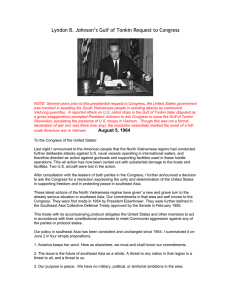
![vietnam[1].](http://s2.studylib.net/store/data/005329784_1-42b2e9fc4f7c73463c31fd4de82c4fa3-300x300.png)
